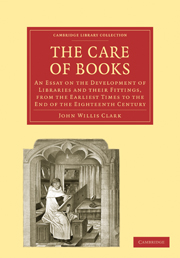 The Care of Books
The Care of Books If the evidence brought forward in the last chapter be accepted, the library which a monastery or a college built in the fifteenth century was a long, narrow room lighted by rows of equidistant windows. Occasionally, if neighbouring buildings allowed, there was a window at the end of the room also. The fittings were lecterns of wood. On these the books were laid, each volume being fastened by a chain to a bar usually placed over the desk, but occasionally, in all probability, in front of it or beneath it. The readers sat on benches immoveably fixed opposite to each window. It is obvious that reading under these conditions would be convenient enough so long as the students were few, but if they were numerous and the books chained too closely together much annoyance must have been caused. When the University of Oxford petitioned Humphrey Duke of Gloucester in 1444 to help them to build a new library, they specially dwelt upon the obstacles to study arising from the overcrowded condition of the old room. “Should any student,” they said, “be poring over a single volume, as often happens, he keeps three or four others away on account of the books being chained so closely together.”
Further, the lectern-system was so wasteful in the matter of space, that, as books accumulated, some other piece of furniture had to be devised to contain them.
To save this book to your Kindle, first ensure [email protected] is added to your Approved Personal Document E-mail List under your Personal Document Settings on the Manage Your Content and Devices page of your Amazon account. Then enter the ‘name’ part of your Kindle email address below. Find out more about saving to your Kindle.
Note you can select to save to either the @free.kindle.com or @kindle.com variations. ‘@free.kindle.com’ emails are free but can only be saved to your device when it is connected to wi-fi. ‘@kindle.com’ emails can be delivered even when you are not connected to wi-fi, but note that service fees apply.
Find out more about the Kindle Personal Document Service.
To save content items to your account, please confirm that you agree to abide by our usage policies. If this is the first time you use this feature, you will be asked to authorise Cambridge Core to connect with your account. Find out more about saving content to Dropbox.
To save content items to your account, please confirm that you agree to abide by our usage policies. If this is the first time you use this feature, you will be asked to authorise Cambridge Core to connect with your account. Find out more about saving content to Google Drive.